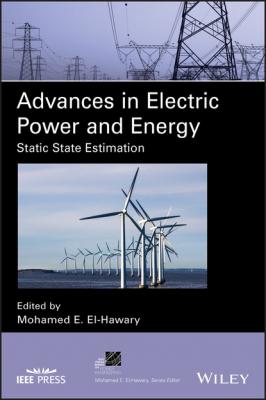Advances in Electric Power and Energy. Группа авторов
Читать онлайн.| Название | Advances in Electric Power and Energy |
|---|---|
| Автор произведения | Группа авторов |
| Жанр | Физика |
| Серия | |
| Издательство | Физика |
| Год выпуска | 0 |
| isbn | 9781119480440 |
In Table 2.12, note that the sum of the optimal binary variables for the LMS and LTS estimators is equal to 11, i.e. to the median. However, the LMR procedure only rejects one measurement. This residual corresponds to measurement V2.
Finally, Table 2.13 provides the estimated voltage magnitude and angle for the WLS, LAV, QC, QL, LMS, LTS, and LMR estimation procedures. For comparison purposes, the second column of this table shows the true state xtrue.
TABLE 2.13 Example of alternative estimators: true and estimated state vectors.
| Estimators | ||||||||
|---|---|---|---|---|---|---|---|---|
| x true | WLS | LAV | QC | QL | LMS | LTS | LMR | |
| V1 (p.u.) | 1.000 | 0.994 | 0.993 | 1.000 | 0.998 | 0.996 | 0.985 | 1.000 |
| V2 (p.u.) | 0.985 | 0.979 | 0.978 | 0.985 | 0.983 | 0.981 | 0.970 | 0.985 |
| V3 (p.u.) | 0.973 | 0.967 | 0.965 | 0.972 | 0.970 | 0.969 | 0.976 | 0.972 |
| V4 (p.u.) | 1.020 | 1.014 | 1.013 | 1.020 | 1.018 | 1.030 | 1.023 | 1.020 |
| θ1 (rad) | 0.000 | 0.000 | 0.000 | 0.000 | 0.000 | 0.000 | 0.000 | 0.000 |
| θ2 (rad) | −0.008 | −0.008 | −0.008 | −0.008 | −0.008 | −0.008 | −0.008 | −0.008 |
| θ3 (rad) | −0.025 | −0.025 | −0.025 | −0.025 | −0.025 | −0.025 | −0.028 | −0.025 |
| θ4 (rad) | 0.038 | 0.038 | 0.038 | 0.038 | 0.038 | 0.035 | 0.034 | 0.038 |
In Table 2.13, note that the best estimates are provided by the QC and LMR estimators, while the performance of the LTS procedure is poor. Note that this conclusion is withdrawn considering only one measurement scenario, a particular metering configuration, and a small 4‐bus system. In order to obtain statistically sound conclusions, the following section provides a detailed analysis of both the numerical and computational behaviors of the aforementioned algorithms, considering 100 measurement scenarios, different measurement configurations, and a large system.
2.5.10 Case Study
In this section, the performance of the mathematical programming estimation procedures described above is analyzed from both numerical and computational perspectives. These state estimation methods are applied to a realistic 118‐bus system. This system corresponds to the IEEE 118‐bus network, which represents a significant area of the American Electric Power system.
For statistical consistency, each analysis is carried out by considering 100 measurement scenarios. Each measurement scenario is synthetically generated from the solution of a converged power flow by adding Gaussian‐distributed random errors to the corresponding true values.
Each scenario involves:
1 A random active/reactive power consumption level.
2 Random locations of voltage and active/reactive power meters (ensuring observability of the whole system).
3 A random redundancy level.
4 Gaussian‐distributed random errors in all measurements (standard deviations of 0.01 and 0.02 p.u. for voltage and power measurements, respectively).
The computational analysis of this chapter has been performed using MINOS [11] and SBB [31] solvers
